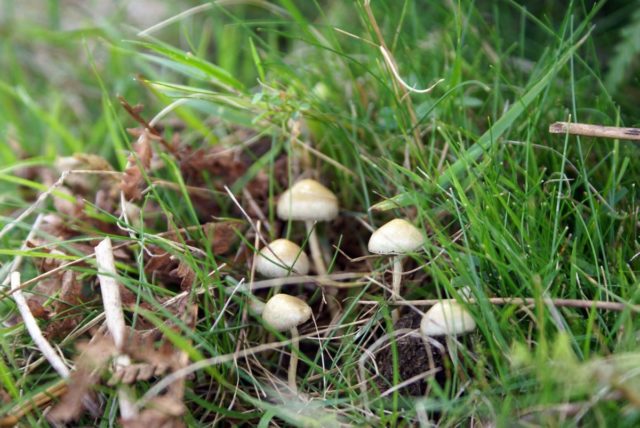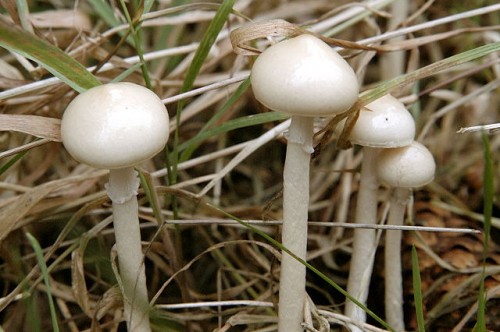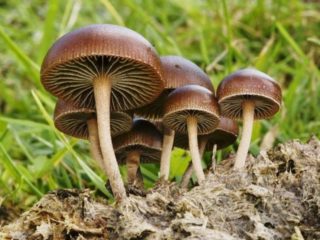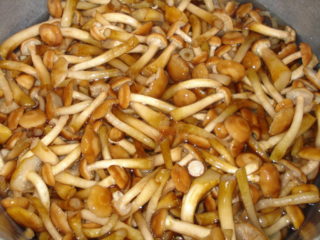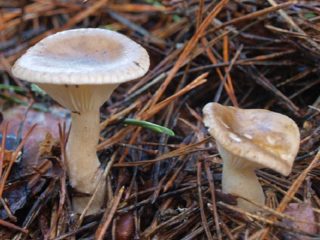Content
Dung bald is an inedible mushroom that, when consumed, has a hallucinogenic effect on humans. The tissues of its fruiting body contain little psychotropic substance, so its psychedelic effect is weak. The collection, sale and use of this mushroom on the territory of the Russian Federation is prohibited.
What does a dung bald spot look like?
Dung bald mushroom (Deconica merdaria) is one of the inedible hallucinogenic mushrooms without clear external distinctive features, but with specific characteristics. It belongs to the Hymenogasteraceae family, genus Deconica.
There are such synonymous names for Dung Bald:
- Stropharia merdaria;
- Psilocybe merdaria.
Description of the cap
The cap of the dung bald cap is soft, smooth, with thin pulp, and has a diameter of 0.8 to 3 cm. In young fruiting bodies, it is compact, bell-shaped, with a tubercle in the center. The edge of the cap is whole, with traces of a common cover. Its color changes depending on humidity. In a dry environment it is pale ocher, in a humid environment it is yellowish-brown. As the mushroom grows, the cap straightens and becomes flat-convex. Its pulp is odorless.
Thin plates with solid edges are initially painted in light colors. Then they acquire a darker shade. They are adherent, sparse, supplemented by intermediate plates.
The spore-bearing layer is brown, with a whitish edge, compressed, widely fused. With age, it becomes covered with dark spots. The spores are black, smooth, oval in shape.
Description of the leg
The stem of the dung baldhead occupies a central position relative to the cap. It is light yellow in color, cylindrical in shape, and spindle-shaped at the base. Its diameter is 1 - 3 mm, and its length is 2 - 4 cm.
On the leg of the dung bald head there is a light, barely noticeable ring that resembles a belt. Below it, the surface is covered with light scales. The structure of the pulp is fine-fibrous. Its color when ripe is light brown.
You can see what a dung bald spot looks like in the video:
Where and how does stropharia dung grow?
Stropharia dung has a wide distribution area. The variety grows throughout the world, predominantly in temperate and subarctic climates.
In Russia, Stropharia dung is found everywhere on fertile soils with a large amount of decomposed organic matter. Its preferred habitat is rotted manure.
Fruiting bodies can be found in pastures and meadows that have a slope and end in a damp lowland, especially with traces of manure. Sometimes dung baldness is found in gardens and vegetable gardens.
Such mushrooms can grow both in groups and in single specimens. Fruiting of the Dung Bald begins in late summer and, provided there is a warm autumn, can continue until the end of October.
Important! It is believed that beyond the Urals, mushrooms containing psilocybin grow poorly.
Is the mushroom edible or not?
Dung bald is included in the list of inedible mushrooms classified as hallucinogenic species. Its fruiting bodies contain substances that have a psychedelic effect on the central nervous system.
The impact of dung baldness on the human psyche
Eating bald dung can have a psychotropic effect on humans. This is explained by the presence in the fruiting bodies of psilocybin, an alkaloid that has the property of putting consciousness into a borderline state (trip). Within 15 - 20 minutes after its use, a person develops symptoms reminiscent of the symptoms of taking the drug LSD, which last 4 - 7 hours. The lethal dose of this component is 14 g, and the dose that causes hallucination is 1 - 14 mg.
Attention! Trip (from English - “travel”) is the name given to the effect of hallucinogenic mushrooms on the psyche. It is long-lasting and makes it possible to experience experiences that go beyond the normal perception of reality.
The psychotropic effect of bald manure is very insignificant and manifests itself as follows:
- a person feels bliss, elation, euphoria, or the opposite feelings of excitement and anxiety;
- bouts of causeless joy arise;
- the surrounding reality is perceived in bright colors, surfaces take on amazing shapes;
- balance and coordination of movements are impaired;
- hallucinations and color visions appear;
- hearing becomes more acute;
- the perception of one’s own body as a whole is distorted;
- The mood changes sharply - from laughter to fits of horror.
Positive emotions after consuming Stropharia dung are expressed in a feeling of all-encompassing happiness and satisfaction. If a person has prerequisites for mental disorders, the result will be unexpected. The negative impact of mushroom hallucinogens can manifest itself in unmotivated aggression, rage, and hatred. These feelings are directed against the person himself. This dangerous condition leads to suicidal actions.
A contraindication to the use of bald manure is a depressed, depressed, anxious emotional state, which under the influence of these mushrooms will only intensify and will have consequences unpredictable for a person. A side effect of taking fruiting bodies manifests itself in the form of disruption of the digestive system: nausea, vomiting, diarrhea, cramps.
Prohibition on collecting and consuming bald manure
The fruiting body of the dung baldhead contains small amounts of psilocybin, which causes hallucinations.Bans have been imposed on hallucinogenic mushrooms in different countries of the world:
- In the UK - for storage, distribution, use of psilocybin fruiting bodies: they are classified as class A substances.
- In the USA - for the storage and use of dung bald, which is listed in Schedule I, based on the UN Convention on Psychotropic Substances of 1971.
- In the Netherlands - for the distribution and use of only dried psychedelic mushrooms. The restriction does not apply to fresh fruiting bodies.
- In Europe, a gradual tightening of restrictions on the cultivation, collection and use of psilocybin representatives is being introduced.
However, in some European countries, for example, in Austria, the use of fresh psychotropic mushrooms is still not prohibited.
In the Russian Federation, a ban on the circulation of mushrooms containing psilocybin, which includes dung bald, is regulated at the legislative level:
- The Criminal Code of the Russian Federation (Article 231) prohibits the cultivation of plants that contain psychotropic substances.
- The Code of the Russian Federation on Administrative Offenses (Article 10.5) contains the rule that failure to destroy plants with narcotic components in their composition entails a fine.
- According to the Decree of the Government of the Russian Federation No. 681 (dated June 30, 1998) “On approval of the list...” psilocybin and psilocin are included in the list of substances controlled in the territory of the Russian Federation.
- By Decree of the Government of the Russian Federation N 934 (dated November 27, 2010), psilocybin-containing mushrooms are classified as plants subject to control on the territory of the Russian Federation.
Doubles and their differences
Dung Bald has an external resemblance to other mushrooms that grow on manure and have the same psychotropic properties. The main difference is that the cap of a mature dung bald specimen becomes open and flat.
Lookalikes of Stropharia dung are also inedible and have a hallucinogenic effect:
- Stropharia shit, it is also called “poop bald spot”.
- Stropharia hemispherical, synonymous name - Treuschling semicircular.
- Psilocybe semilanceolate. Other common names are Liberty Cap, Sharp Conical Bald Head.
Conclusion
Dung Bald is a mushroom that can cause hallucinations in humans when consumed. It grows mainly in meadows and pastures on moist soil made from rotted manure. The fruiting bodies of this variety can be found from August to October. In Russia, collecting and consuming them is prohibited by law.





